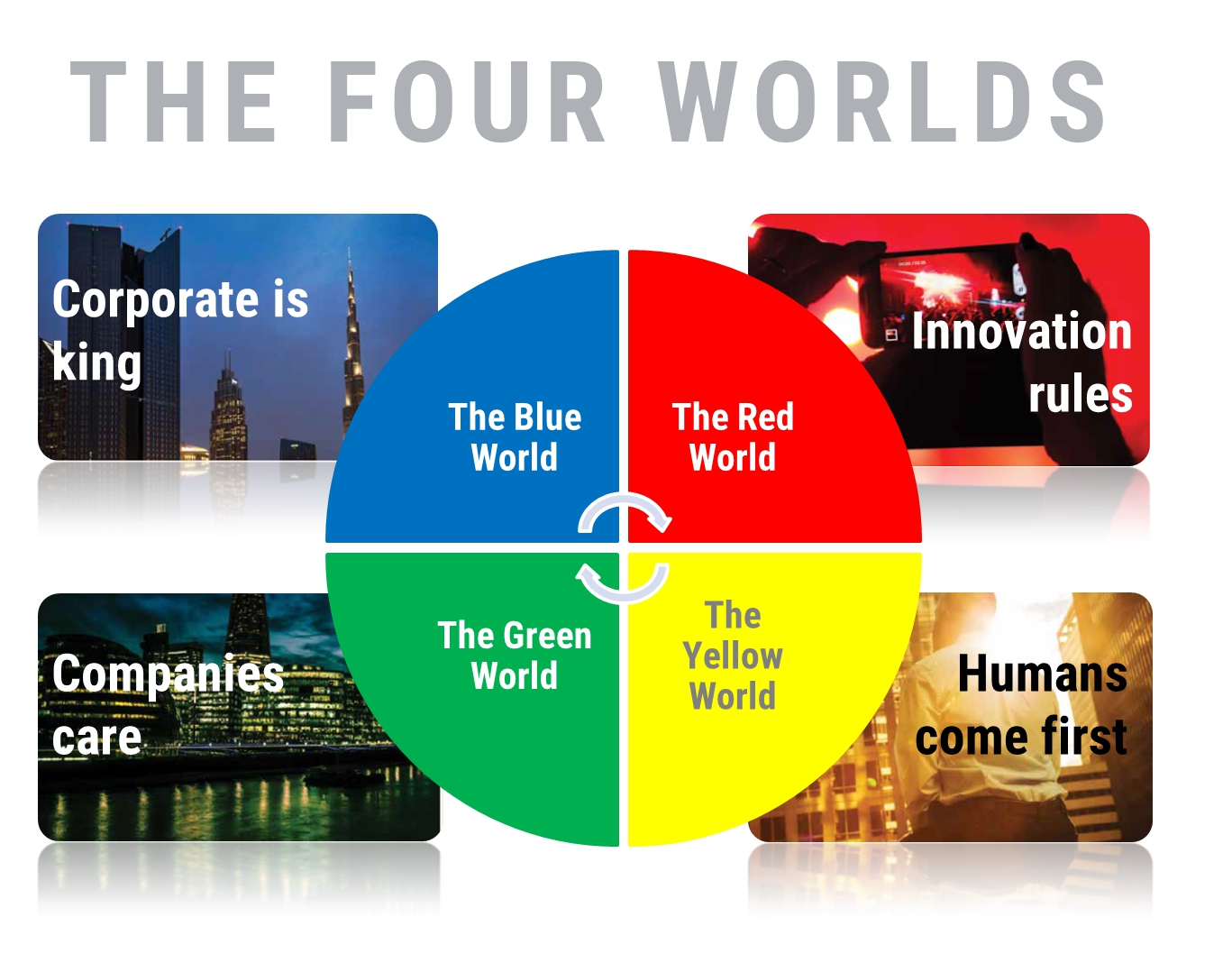
As technology advances at an unprecedented pace, the future of work is a topic of increasing importance and speculation. Historically, technological advancements have reshaped industries and rendered certain job roles obsolete. Now, with the rapid evolution of artificial intelligence, automation, and other emerging technologies, the question arises: What will job roles look like in 2030? In this article, we’ll explore this question, examining both historical trends and current developments to anticipate the potential scenarios that lie ahead in the world of work. Join us as we peer into the future and consider the implications for workers and businesses in the coming decade.
Four possible worlds of work in 2030
PwC has envisioned four distinct scenarios for the future of work, each represented by a different color: Red, Blue, Green, and Yellow. These scenarios offer different outlooks on how labor dynamics might unfold in the coming decade.

The red world
Technology empowers small businesses, diminishing traditional HR functions. Entrepreneurs compete fiercely for talent with in-demand skills.
Key Traits: Agility, innovation, intense competition, outsourcing HR.
The blue world
Global corporations grow larger and more powerful, prioritizing scale to protect profit margins.
Key Traits: Corporate consolidation, increased competition for talent, globalized economy.

The green world
Companies respond to environmental concerns and regulatory pressures, embracing sustainability and corporate responsibility.
Key Traits: Environmental stewardship, social responsibility, ethical agendas.
The yellow world
Individuals and organizations prioritize meaning and purpose in work, emphasizing autonomy, flexibility, and fulfillment.
Key Traits: Employee well-being, strong ethical and social standards, fair compensation.
These scenarios offer insights into potential future work dynamics, reflecting diverse societal values, economic trends, and technological advancements. Understanding these possibilities can help stakeholders prepare for the challenges and opportunities ahead in shaping the future of work.
10 key trends for the next 10 years
- Diverse workspaces: employees choose where they work, with no assigned seating.
- Smaller corporations: collaboration reduces the need for large organizations.
- Flatter hierarchies: shared leadership fosters teamwork.
- Focus on wellness: healthier work environments improve employee well-being.
- Chief of work role: new leadership position for shaping workplace culture.
- Dynamic floor plans: wearable tech guides employees to optimal workspaces.
- Virtual workstations: physical desks become obsolete, replaced by virtual setups.
- Robotic assistants: AI helps with tasks like scheduling and data analysis.
- Global brainstorming: virtual meetings enable seamless idea sharing.
- Virtual networking: VR platforms facilitate informal gatherings and networking.
These trends reflect the evolving workplace, driven by technology and changing expectations.
Megatrends in job roles

- Shift in Occupations: Pearson predicts significant changes in job roles, with only one in five workers remaining in current positions.
- Sector-Specific Changes: Certain sectors like agriculture and healthcare will see shifts in job demands, with only one in ten workers in growing occupations.
- Uncertainty in Job Landscape: Seven in ten workers face uncertainty about future job roles, highlighting the need for adaptability.
- Importance of Cognitive Skills: Higher-order cognitive abilities such as problem-solving and creativity will be crucial for future job roles.
- Technological Proficiency: Skills in IT, data analysis, and engineering will be highly sought after, reflecting the growing influence of technology across industries.
Most in-demand skills for the future of work
- Higher Cognitive Skills: These encompass advanced literacy, critical thinking, and quantitative analysis. Professions like doctors, accountants, and researchers rely on these skills for complex problem-solving and decision-making.
- Social and Emotional Skills: These include advanced communication, empathy, adaptability, and continuous learning. Jobs in business development, programming, and counseling require these skills for effective collaboration and client interaction.
- Technological Skills: This category ranges from basic to advanced IT skills, data analysis, and engineering expertise. Professions in IT, data science, and engineering demand proficiency in these areas for innovation and problem-solving.
These in-demand skills reflect the evolving needs of the future job market, emphasizing the importance of cognitive, social, emotional, and technological competencies for career success.
Top future jobs in 2030
- Virtual Store Sherpa: These professionals focus on customer satisfaction by providing virtual advice on product lines. They play a crucial role in enhancing the online shopping experience and driving sales in e-commerce.
- Personal Data Broker: Responsible for ensuring consumers receive revenue from their data, setting prices, and executing trades. They navigate the complex landscape of data privacy and monetization, empowering individuals in the digital economy.
- Personal Memory Curator: Consults with patients and stakeholders to create specifications for virtual reality experiences, leveraging technology to enhance memory and cognitive function.
- Augmented Reality Journey Builder: Collaborates with engineers and artists to develop essential elements for immersive experiences, shaping the future of entertainment, education, and training.
- Highway Controller: Monitors automated road and airspace management systems to ensure safe and efficient transportation, facilitating the transition to autonomous vehicles and drones.
- Body Part Maker: Utilizes advanced biotechnology to create living body parts for medical purposes, revolutionizing healthcare and enhancing quality of life for patients.
- Nano-medic: Implements cutting-edge medical technologies at the nanoscale to diagnose and treat diseases, paving the way for personalized and minimally invasive healthcare solutions.
- GM or Recombinant Farmer: Transforms agriculture and livestock farming through genetic modification and recombinant DNA technology, addressing food security and sustainability challenges.
- Elderly Wellness Consultant: Specializes in providing holistic care and support for the physical and mental well-being of the elderly population, catering to the needs of an aging society.
- Memory Augmentation Surgeon: Enhances patients’ memory capacity through surgical procedures and neurotechnology, unlocking new possibilities in cognitive enhancement and neurological rehabilitation.
- ‘New Science’ Ethicist: Guides ethical decision-making in emerging fields such as biotechnology, artificial intelligence, and space exploration, ensuring responsible innovation and societal benefit.
- Space Pilots, Tour Guides, and Architects: Facilitates human exploration and habitation of space by piloting spacecraft, leading tours of extraterrestrial environments, and designing habitats for lunar and Martian colonies.
These innovative job roles reflect the transformative impact of technology and emerging industries on future careers, presenting exciting opportunities for individuals to contribute to society and drive economic growth in the 21st century.
Job interviews in 2030
In 2030, job interviews are poised to undergo a significant transformation, leveraging advanced technologies to enhance the hiring process and identify the best candidates for the job. A comparison between current interview practices and future scenarios envisioned by the Wall Street Journal (WSJ) highlights the evolution towards more efficient and data-driven selection methods.

Current practices
Traditional job interviews often rely on subjective assessments by hiring managers, which may introduce biases and inaccuracies into the decision-making process. Candidates are typically evaluated based on their resume, cover letter, and performance during face-to-face interviews, with limited insight into their true capabilities and potential for success in the role.
Future scenarios
- Personality Profiling with AI: Employers will increasingly use artificial intelligence (AI) algorithms to analyze candidates’ social media profiles and online behavior, creating personality profiles that provide deeper insights into their suitability for the job. By examining communication patterns, interests, and values, AI-driven personality assessments can help identify candidates who align with the company culture and job requirements.
- A ‘Credit Score’ for Skills: In the future, companies may adopt automated systems to assess candidates’ skills and competencies based on the content they generate online, such as blog posts, coding projects, or contributions to open-source communities. Similar to a credit score, these algorithms assign a numerical value to each candidate’s skillset, enabling employers to quickly evaluate their qualifications and potential fit for the role.
- Virtual Reality Job Performance Testing: Virtual reality (VR) technology allows employers to simulate real-world work scenarios and assess candidates’ job performance in a controlled environment. By immersing candidates in interactive simulations and observing their actions and decision-making processes, hiring managers can gain valuable insights into their problem-solving abilities, communication skills, and adaptability.
- Wearable Health Technology: Wearable devices equipped with biometric sensors enable employers to monitor candidates’ physiological responses during interviews, such as heart rate, stress levels, and cognitive engagement. By analyzing these metrics in real-time, recruiters can gauge candidates’ emotional intelligence, resilience, and suitability for high-pressure roles, enhancing the accuracy and objectivity of the hiring process.
Implications and benefits
- Efficiency and Objectivity: AI-driven assessments and virtual reality simulations streamline the interview process, reducing time-to-hire and minimizing human bias. By relying on data-driven insights rather than subjective judgments, employers can make more informed hiring decisions and identify candidates who possess the right combination of skills and qualities for the role.
- Candidate Experience: While technology plays a crucial role in modernizing the hiring process, it’s essential to prioritize the candidate experience and ensure that applicants feel valued and respected throughout the interview process. Transparent communication, personalized interactions, and feedback mechanisms help candidates navigate the recruitment journey with confidence and trust in the organization.
- Continuous Learning and Adaptation: As technology continues to evolve, employers must remain agile and adaptable, embracing new tools and methodologies to stay ahead of the curve in talent acquisition. By fostering a culture of continuous learning and experimentation, organizations can harness the full potential of emerging technologies to attract, engage, and retain top talent in an increasingly competitive job market.
Conclusion
The future of work in 2030 promises to be shaped by transformative trends and technological advancements that will revolutionize industries, job roles, and the way we work. From the emergence of innovative job titles to the adoption of AI-driven interview methods, organizations and individuals alike must prepare for the opportunities and challenges that lie ahead.
Embrace the future of work with confidence, curiosity, and a commitment to lifelong learning. Together, we can navigate the opportunities and challenges of the digital age and build a brighter, more resilient future for individuals and organizations alike.
If you want to reach new GEOs and audiences, maybe it is all waiting for you on Telegram? We’ve prepared some material about Telegram audiences. What are the messenger’s users like this year? How old they are, what they do, and what they are interested in!






